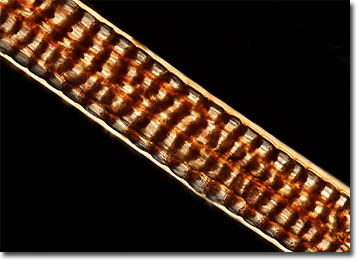Polarized Light Microscopy Digital Image Gallery
Russian Cony Hair
Cony, also spelled coney, is a term used to refer to several different unrelated animals, but in the fur industry is typically indicative of rabbit fur. Indeed, though this common name for the rabbit is falling out of favor in modern times, it was once widely utilized and was, in fact, the origin of the name of Coney Island, a location where settlers found large rabbit populations.

View a second image of Russian Cony Hair
The Russian cony, or rabbit, is known by many names throughout the world and is perhaps more popularly referred to as the Himalayan. Though generally believed to be one of the oldest surviving breeds, little about the true history of the animal is known. Some believe, however, that the rabbit was originally an inhabitant of the Himalayan Mountain Range, though there is little evidence to support such a claim. Others argue that the breed was developed from a wild strain of silver-colored rabbits, citing the fact that many Russian rabbits today begin their lives with silver-gray coats, although their coloring changes as they mature, adults of the breed exhibiting a snowy white over most of the body, but a dark brown, black, or bluish-hue at the extremities.
Though the thick, plush fur of the Russian cony was once considered the best rabbit fur available, the development of newer, improved breeds has displaced this animal as the most desirable in the industry. The Castor Rex, for example, which was developed in the early 1900s, is a variety of rabbit that contains no long, stiff guard hairs in its coat. This selectively produced characteristic greatly simplified the process of readying rabbit pelts for the market, since no removal of the undesirable guard hairs was necessary. The satin Angora rabbit is another relatively new breed that exhibits fur that is considered more valuable by some than that of the Russian rabbit. By crossing a French Angora with a longish-haired mutation of a shorthaired satin rabbit, an animal with an unusually long, shiny coat was developed.
